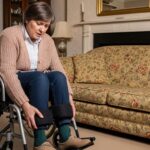If you spend 2-3 hours a day in a wheelchair, you’ll know how annoying back pain and leg discomfort can be. Ever felt like your legs are heavy by the afternoon? Or have an ache in your lower back that won’t go away? The cause might be simpler than you think – not having the right footrest.
Choosing the right footrest isn’t just about comfort – it’s essential for anyone who sits for long periods, especially at a desk. The truth is most people completely overlook this simple yet powerful ergonomic support.
In this post, we’ll show you how to choose the best wheelchair footrest for you – one that will keep you comfortable and support your health in the long run. A small change like this can make a big difference to your daily comfort, posture and even your productivity.
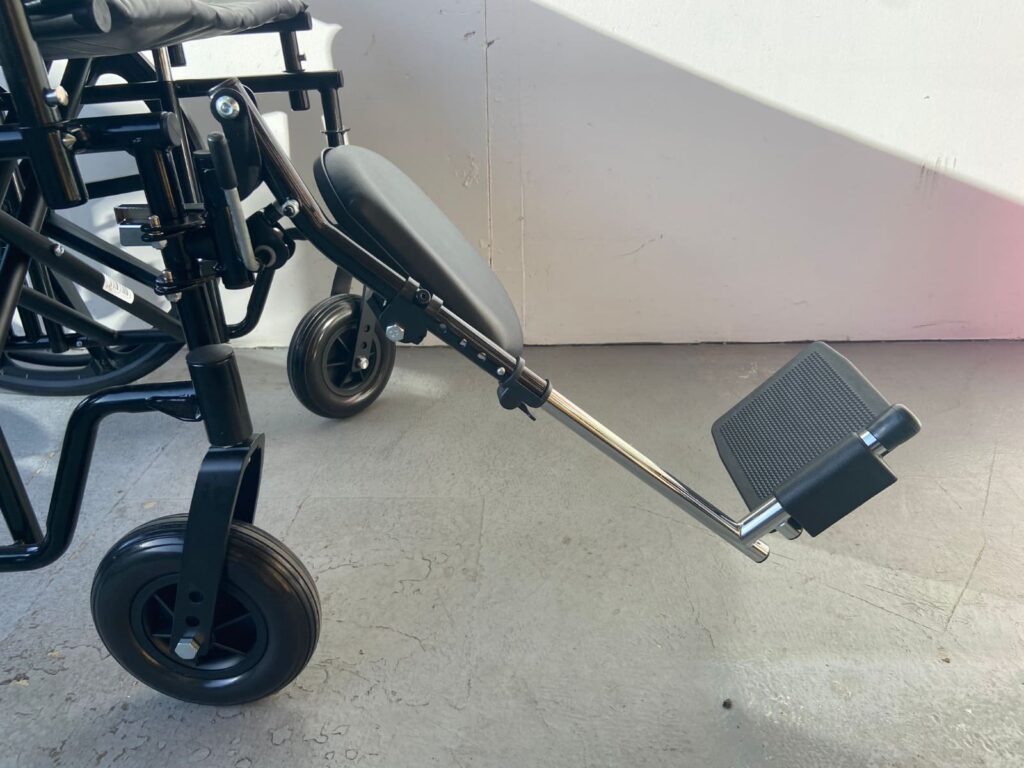
Table of Contents
Why Footrests Are the Best Solution
Let’s be real, when your footrest isn’t at the right height, your body starts to adjust in weird ways just to stay balanced. What seems like a small issue can actually cause a chain reaction:
- Your spine loses its natural curve
- Your hips go out of alignment
- Blood flow to your legs slows down
- Unwanted pressure builds up in certain areas
Over time, these can lead to ongoing discomfort, stiffness and even pain. But with the right foot support, many people find they feel more comfortable, more stable and better supported throughout the day.
The Hidden Dangers of Poor Foot Support
The problems caused by poor foot positioning go way beyond a bit of discomfort. Here’s what can really happen:
Poor Circulation: When your feet aren’t supported, blood flow slows down. This often leads to swelling, numbness and that annoying tingling feeling in your legs and toes – all of which makes it hard to focus.
Loss of Focus and Comfort: It’s hard to concentrate when you’re constantly shifting about to get comfortable. Discomfort is one of the biggest reasons people lose focus while working or sitting for hours.
Long Term Health Issues: That small ache you’re ignoring today could turn into something serious down the line. Misalignment, poor posture and constant pressure can lead to long term joint or back problems if not addressed early.
Mental Fatigue: Bad posture isn’t just hard on your body – it tires your mind too. When your muscles are straining to keep you balanced, you’ll likely feel exhausted by the end of the day, even if you haven’t moved much.
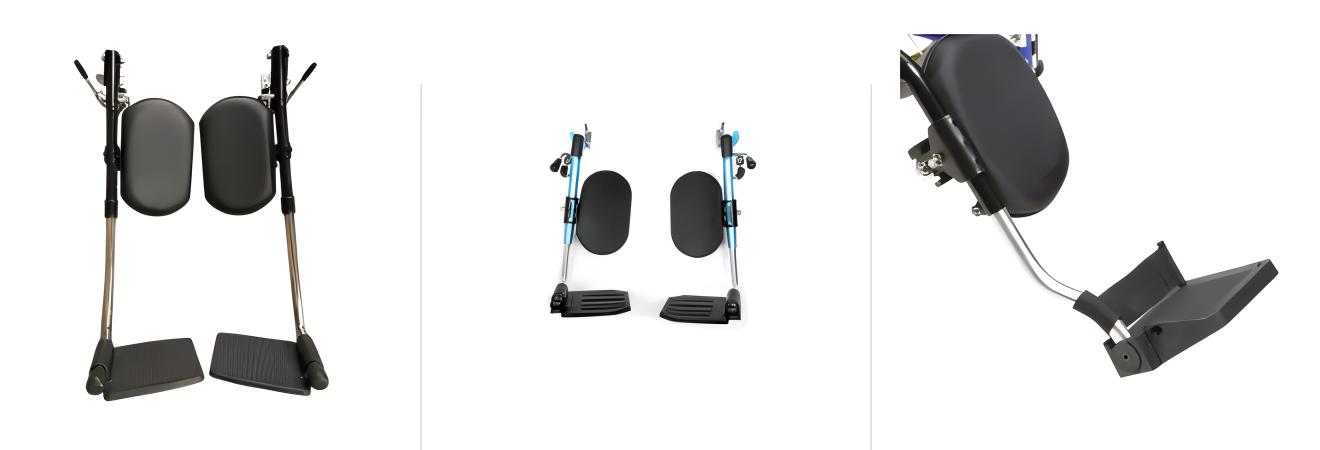
Types of Wheelchair Footrests
There are many types of footrests out there but not all are for everyone. Each one serves a purpose depending on your needs. Time, pain, how you sit, how long you sit – it all matters. Some footrests are standard, some flip up or swing away, and some elevate your legs for better blood flow. So choose what works for you. Knowing what fits your wheelchair is one thing; knowing what fits your legs is what makes the difference. Here are some of the most common types of wheelchair footrests:
1. Fixed Footrests
Fixed footrests are built into the frame of the wheelchair and can’t be removed or swung away. They’re usually found on basic or budget models.
Pros: It is good for people who don’t need to transfer frequently and use their wheelchairs for short periods.
Cons: Gets in the way during side transfers or when getting close to tables
2. Swing-Away Footrests
These are the most common types. Swing-away footrests can be moved to the side or removed when not needed.
Pros: Everyday users who need more flexibility when getting in or out of the chair. Easier transfers and Ideal for storage and transport
Cons: Hinges may wear with frequent use
3. Elevating Leg Rests (ELRs)
Elevating leg rests let you lift and lower your legs to your comfort. They’re great for people with leg injuries, poor circulation or recovering from surgery.
Pros: Anyone who needs to reduce swelling and keep their legs up all day. It supports healing
Cons: Adds bulk and weight to the wheelchair
4. Articulating Leg Rests
These are the upgraded versions of ELRs. As you lift your legs, the articulating leg rest also extends out, keeping your leg supported.
Pros: Better leg alignment, more comfortable than standard ELRs, and best for taller users or people with limited knee movement.
Cons: Heavier and more expensive
5. Detachable Footrests
Detachable footrests can be removed with a quick-release mechanism. They’re useful when folding the chair or storing it in a car boot.
Pros: Lightweight and convenient, Great for tight spaces or users who travel often or want to save space.
Cons: Needs to be reattached every time
6. One-Piece Footboard
Instead of two separate footrests, this design has a single platform – a one-piece footboard. It’s used in children’s wheelchairs or where better foot control is needed.
Pros: Best for users with reduced foot stability or children who move around more. Keeps feet from slipping, full foot support.
Cons: Not adjustable for different leg lengths
7. Amputee Leg Support
For amputees. A padded support platform that cradles the residual limb.
Pros: Best for one or both legs amputated. Stable and safe, reduces pressure and discomfort
Cons: Needs to be customised for individual needs
Footrests in our shop
U-GO Atlas Elevating Leg Rests
If you use a U-GO Atlas wheelchair, these leg rests lift your legs, hold them steady and let you change the length. When you sit for hours, blood flows better, pain feels less and you don’t need to shift as much.
They look like they belong with your chair. All black. The calf part feels soft, the foot bit moves out of the way when you don’t need it, and you can set it as high or low as your body needs.
Good to know:
- Made for U-GO Atlas wheelchairs, not others
- You can raise them, adjust them, flip the foot part up
- Calf support is soft and stays gentle
- You can take them off when not needed
Things to check:
- Only made for U-GO Atlas, not a match for other wheelchairs
- Always check your model before you buy
Best if:
You sit in a U-GO Atlas wheelchair and want comfort, leg lift and ease when you rest for long or move less.
Esteem Elevating Leg Rests
These ones are for style and care, both. If you use an Esteem wheelchair, these leg rests match you. They come in sky blue or silver so they stand out. But they don’t just look good. You can lift your legs, change the height, shift the calf bit as you like and even turn it into a stump board by taking the foot part off.
You need to check your model, though. They don’t fit all Esteem chairs, only the ones marked from 001B to 009.
Good to know:
- Height moves how you want
- Calf pad is soft and helps when pain stays
- You can take them off or store them with ease
- Can be turned into a stump board
- Comes in colours that feel bright
Things to check:
- Only works with select Esteem wheelchairs
- Fits users up to 18 stone (115kg)
Best if:
You use an Esteem wheelchair and want leg lift that feels smooth, soft and easy, especially when you are healing, or when sitting for long hours becomes part of your day.
Drive Medical Aluminium Elevating Leg Rest
this one is light, simple and sure. If your chair is by Drive Medical or Medicare Enigma, this might be your fit. Made of aluminium, it doesn’t feel heavy but is strong. The calf support is soft, the leg height adjusts and you can take it off without hassle.
Not for hard knocks like steel but for daily use, it feels right.
Good to know:
- Height adjustable as per your need
- Soft calf pad, feel comfortable
- Light to lift, but strong enough
- You can remove it without tools
- Fits many Drive or Enigma wheelchairs
Things to check:
- Only fits chairs made by Drive or Enigma
- Not meant for very high weight or heavy impact
Best if:
You want a elevating leg rest that feels light but works well, one that adjusts, supports and comes off easy and you use a Drive or Enigma wheelchair.
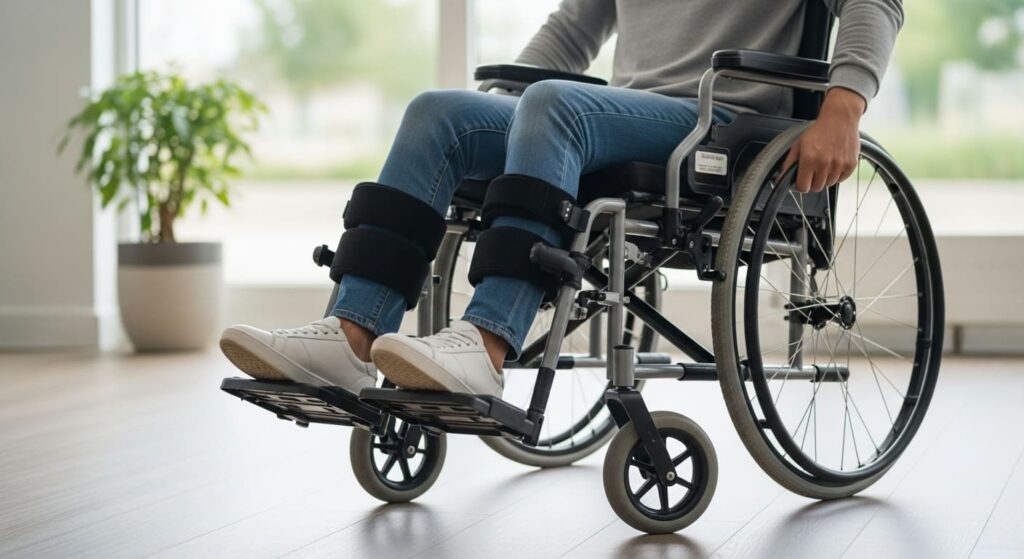
Key Features to Consider
What matters most when choosing the right footrest is a few simple things.
How High It Goes
Chair, desk, legs – all three must work together. Your feet should rest flat, knees bent. Look for a rise of at least 15cm. You sit better when your legs sit right.
Surface That Holds Your Feet
Feet slip when shoes are smooth. A good footrest keeps them still. Some have raised lines or ridges. Some feel like small hands pressing soft. That helps feet stay where they need to stay and keeps the blood flowing.
It Must Not Move
If it wobbles, it hurts. If it shakes, your legs feel it. Look for strong sides, tight locks, firm grip. It should not feel added. It should feel like it belongs with the chair.
What It’s Made Of
- Aluminium or steel that lasts
- Soft top that doesn’t bite
- Coated to fight rust outside
- Kind to skin you touch every day
Size That Fits The Floor And Your Feet
Small ones look neat, but can press in the wrong way. Your foot needs room, not just a place. Choose the one that fits both space and shape.
What A Good Footrest Can Do
Helps Blood Flow
Right feet place means right blood flow. Less swelling. Less chance of clots. If you sit long, this matters more.
Takes Pain Out Of The Back
Your back stays strong when your feet sit well.
Keeps The Mind Clear
When the body rests, the brain works better. People feel calm, make less mistakes, stay sharp.
Stops Bigger Pain From Growing
Pain starts small. Bad sitting turns it big. A good footrest can stop back pain, stop blood from slowing, stop joints from breaking down.
Sleep Comes Easier
The body that sits well all day sleeps well at night. When muscles rest, and blood keeps its pace, sleep feels deep.
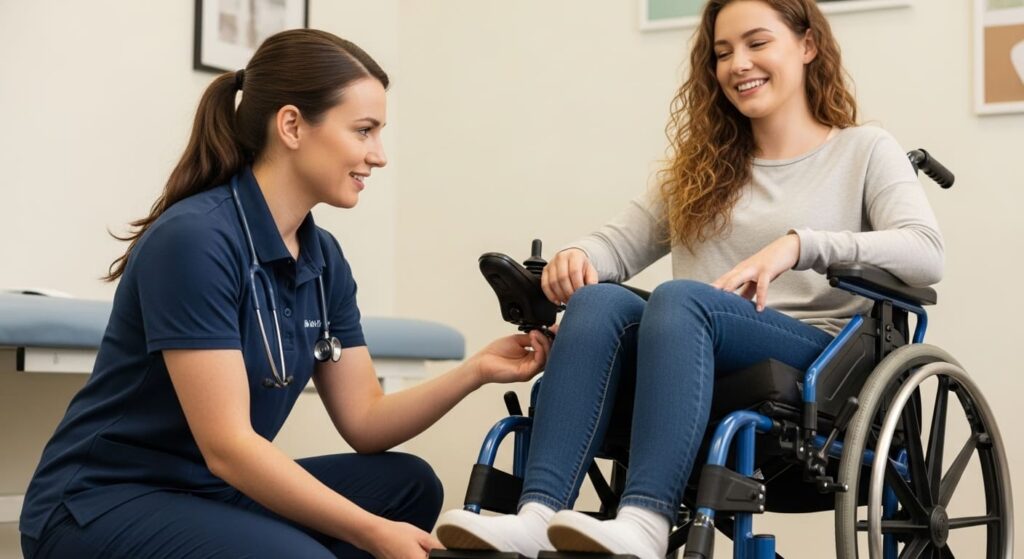
When You Sit, Your Feet Deserve Care Too
Let’s be real, footrests aren’t about looks; they change how you feel. If you sit for hours, this little support can be a quite helpful every day.
It’s not just comfort. The right footrest gives better flow in your legs, better hold in your back and more strength in how long you can sit. Your feet stay where they should, your body stays aligned and your mind stays on the task. Ask yourself once, is your space helping you or making you tired?
You can change that. You can choose what makes sitting less hard. A simple thing, a quiet fix that talks to your body nicely. If this helped you, leave a comment below. Share it with those who sit like you do, work like you do. They matter too.
Take care of your legs, your back, your feet. They carry you. Let them rest right. You can find footrests that fit you well at MobilityShop.
FAQs about Wheelchair Footrests
Why does a footrest matter when I sit in a wheelchair?
When your feet hang, they pull. That pull goes up, to your legs, your back, till the sit becomes hard. A footrest is where the feet stop. No pull, no swing, no slip. It keeps them still, held, right. It’s not just for rest, it holds you right
How do I know which footrest feels right for me?
Sit comfortably and let your feet down. If they reach soft, stay still, no slip, it fits. Some feel right when high, some low, some need elevation. Your legs will tell you. If they feel light, if they don’t need to move, it works.
Is an adjustable footrest better than a fixed one?
If you change your seat, move to bed, turn your legs, or sit long, an adjustable footrest gives room. It flip up, flip down, turns a bit. A fixed one stays still. If your day stays the same, that may be fine. But if you shift, adjust, change – you’ll feel the need for more give.
What if my feet feel sore even with a footrest?
It might mean the support isn’t in the right place, or your leg is bent too much, or your foot is slipping again. Try a cushioned footplate. Try adjusting the height. Try a gentle tilt. Your feet should feel light – not pressed, not dangling. The right setup makes you forget they’re even there.
Can I carry a footrest when I travel?
Some fold, some roll, some go flat. If your footrest packs small or fits in a bag, then yes. It must be light, easy to grip, not sharp, not loose. You will need help if it’s big. But many now are made to move with you.

